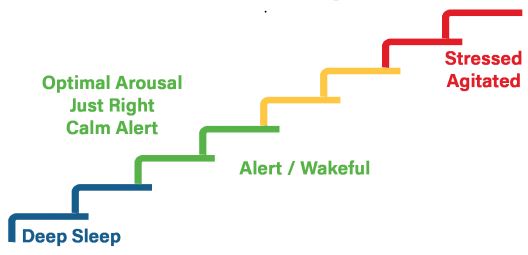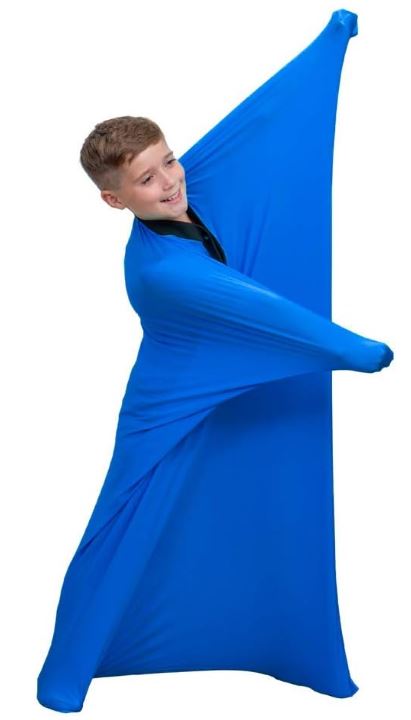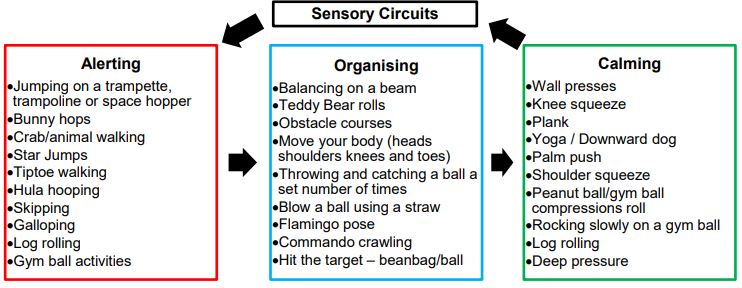The Children’s Occupational Therapy Team plays a vital role in helping children and young people with sensory regulation difficulties. The team uses and recommends various techniques to help individuals better process and respond to sensory input from their environment and their own bodies. This can improve their ability to participate in everyday activities, manage emotions, and engage with others. Open the categories below for further information:
Sleep Information
If your child has Autism this could frequently have an impact on their sleep routine due to heightened sensory input and difficulties with self-regulation. The excitability before bed may be linked to sensory overload or an inability to effectively calm down after a stimulating day.
It is important to decide on a bedtime which is suitable for your child’s age. Putting them to bed at the same time each night and waking them at the same time each morning; including at weekends will strengthen their body clock and help them to develop a regular sleep and wake cycle.
Sleep needs change as children get older. It helps to have an idea of how much sleep your child needs as this will be different depending on their age. All children are unique, and some will need more or less sleep than others. Your health visitor or GP may be able to advise you on this.
Daytime naps can help prevent young children becoming overtired. However, these should be scheduled to ensure your child does not have a prolonged nap in the late afternoon which is too close to bedtime.
Prepare your Child for Bed
A consistent bedtime routine is important as it teaches your child what to expect in the time leading up to bedtime.
- All electronic devices should be turned off at least one hour before bedtime this includes T.V, computers, games consoles and mobile phones. The blue light from screens stimulates brain activity which delays the onset of sleep.
- Help them to become involved in a quiet, relaxing activity such as colouring/drawing or building a jigsaw in the lead up to bedtime.
- Baths are helpful but only if your child finds them relaxing. Ideally a bath should take place at least 30 minutes before bedtime.
- The bedtime routine should last about 20-30 minutes and have an end-point which your child will know means it is time to go to sleep, such as turning out the light and saying goodnight and leaving the room.
Gradual Stages of Change
If your child will not settle to sleep by themselves and needs you with them this is a useful method of helping them to learn to settle to sleep alone. Rather than leaving your child to cry, you can gradually increase the distance between you and your child over a period of time until they no longer need you beside them to fall asleep. This can take a period of weeks and should begin with you sitting on a chair by the child’s bedside and gradually moving the distance of the chair from the bedside until you are able to sit outside the door. If your child wakes you should return to the stage you were at when you had settled your child to sleep.

Bedroom environment
- Consider position of bed within the room – would he prefer to look towards the door for instance.
- Ensure that a child’s bed is associated with sleeping, not with playing. If possible do not keep toys in the bedroom (or put them away in cupboards as part of the bedtime routine).
- If your child is awake in bed for more than 20 minutes, they will associate being in bed with being awake, rather than with being asleep. Consider moving them downstairs until they feel sleepier.
- Check your child’s bedroom for noise levels, temperature, light or anything else which might be disturbing their sleep. For example, extended hours of daylight in summer can cause problems with settling and early waking, so fitting blackout blinds may be helpful.
- Aim to use calming colours (neutrals, blues, lilac for example) and avoid bright stimulating colours e.g., wall colours.

Regulation
Arousal is the level of alertness in the body. Optimal arousal is when the alertness level is ‘just right’ for the situation (e.g., optimal arousal at night is low enough to sleep, optimal arousal at school is high enough to concentrate and learn).
Regulation is the ability to adjust the arousal level to match the task and the environment. Levels of arousal fluctuate throughout the day and regulation adjusts accordingly.
Dysregulation is the opposite of regulation, when a child is not at the optimal level of arousal for the situation. It is difficult to maintain optimal arousal for any situation at this level.
Co-Regulation is when somebody helps another person to regulate. Younger children often require support of an adult to help them learn how to regulate themselves. This could be support to calm down or to increase their alertness level.
Self-Regulation is when a person manages to regulate themselves without support from others. Children often need access to regulation strategies that they can use.
All individuals experience times throughout their day when they become over alert, under alert. As adults we develop strategies to help us to return to a calm alert state. For example, having a hot drink, deep breath and a break (calm), chewing a sweet, move away from desk (alert). Children benefit from support to develop
strategies. Some individuals may benefit from more input than others.
Calm Sensory Space
A child can display tricky physical behaviours when feeling frustrated or upset. At these times they will benefit from immediate calming strategies. Try to provide a safe place where the child can express anger physically. Activities could include:
- Thumping a therapy ball/pile of cushions. This may be particularly effective if rhythmical fist, thumping is encouraged, think drum beats.
- Jumping and crashing; use a large beanbag/trampoline.
- Cushion/’punch bag;’ this could be created using a laundry bag filled with a single duvet or scrunched balls of newspaper.
- Kicking a ball against the wall.
- Playing with firm theraputty can be used to stretch and squeeze to let out frustrations.
- Access to a ‘chill out zone’ at home, a space where they can go when feeling overwhelmed. ‘Comfort corners’ using beanbags, old, large soft quilts/soft blankets (ideally with nice smell), dark sunglasses, headphones/ear defenders/calming music, dim lighting.

Most children benefit from regular movement breaks to encourage their regulation, promote a calm and alert presentation. Regular access to heavy muscle work activities can be particularly beneficial (proprioception). These are activities when muscles are working harder, e.g., pushing and pulling tasks such as tug of war,
weight bearing on her arms over a ball, etc. This can also include chewing a firm snack. Heavy muscle work/proprioceptive activities will increase the feedback your child is receiving to their muscles, encouraging their body awareness, perception of force and may also have a calming influence.
Try to spot potential ‘triggers.’ For example, if you know you child may experience distress in a particular activity such as a transition, hair brushing, etc., try to deescalate before the task by completing sensory strategies and calming activities before and after these task (as well as regularly throughout the day).
Flexible Trug/Bucket:
- The trug bucket can be used as a portable safe space that they could access to
give her deep pressure by squeezing their body into a small space. - You could add the Lycra sheet over the top of the trug bucket so that they can
get deep pressure by pushing up against the Lycra. Squeezing into a small
space and then climbing out of this will increase the proprioception they receive.
Peanut Ball or Yoga Ball:
Peanut ball activities are great for getting calming proprioceptive input to the whole body. - Roll over the ball on their tummy or back. Ensure to complete slow rhythmical rocks back and forth so that their head and knees lightly touch the floor (when on tummy).
- The ball can be used to bounce on either straddled or side sitting. Follow bouncing activities with deep pressure.
- The ball can be used to apply deep pressure by rolling the ball over the child whilst they are laid down, adjust the pressure applied depending on what the child prefers.
Vibration: - Vibration is another way to get deep pressure and the child would be able to do it
for themselves. - Ensure to press firmly rather than light pressure as this can be alerting.
- Use the massager over whole body, arms, legs, back, hands, feet and jaw. Only use on parts of the body that they can tolerate.
- Vibrating massagers can be found on a number of different websites in various
shapes and sizes.
Lycra: - Lycra (or a stretchy material) could be used to provide deep pressure to increase sensory feedback and enable the child to regulate their sensory system it provides a calm and organised effect on the body.
- Let the child tightly wrap the Lycra material around themselves. Or wrap the child up and let them push his way out.
- Wrap the Lycra around themselves shoulders and back. Ask them to push back
against the Lycra. - If you have two adults, you can gently swing the child in the Lycra like a swing.
- A sheet of Lycra can be purchased at 1st For Fabrics. Cool shades would be
recommended, try to avoid bright colours. Therapist recommends mid tone blue,
dark blue, black, dark purple, green, turquoise. These type of colours can also be
see through once stretched. Over a metre would be suggested possibly 1m 50cm. - Body socks can be purchased from a number of different websites and work in the same way as a Lycra sheet but your whole body is enclosed so you can stretch out and get the proprioceptive input.
- Lycra swings are available for indoors and outdoors however can be very
expensive, please speak to your therapist if you would like to complete a charity
application for these sensory pieces of equipment. - Always supervise the child when they are using these products.

Weighted Blanket:
- A weighted blanket can help to provide extra proprioception (muscle feedback). These can be effective for children who move excessively, to calm and sit still for longer.
- Weighted blankets can be loaned from the Toy Library at the Elgin Centre/Chowdene children’s centre.
- The weight and size of the recommended cover must be appropriate to the child’s physical characteristics. Generally, it is recommended that the blanket should be no more than 10% of the child’s body weight.
- A weighted object should only be used for 20-minute intervals and the child should always be supervised when using this. The weighted blankets must never be used as a restraint. The child must always be able to get free of it by themselves and their head and neck must always be free. A child must never be left without supervision because special attention must be paid to signs that mean the cover must be removed. These include; breathing difficulties, nausea, behavioural or physical reactions showing discomfort or anxiety in a child. A weighted cover should never be used during sleep, as it should be used for no more than 20 minutes and the signs that it needs to be removed cannot be observed when you are both asleep. Some parents use these as part of the bed-time routine, to help with calming before going to sleep.
Oral Stimulation
Sensory processing difficulties can result in the need to seek oral stimulation. Oral stimulation such as chewing can help with body awareness and self-soothing behaviour. Some reasons for seeking oral stimulation include: - Medical: easing pain, alleviating discomfort
- Sensory: seeking texture and taste, overwhelming environment, sensory overload.
- Behavioural: lack of understanding, relieving stress and anxiety, avoiding something, looking for attention, noisy thoughts and uncontainable emotion.
Strategies to support oral stimulation include: - The handheld vibrating massager can be used around the jaw to increase stimulation for 1 minute at a time.
Strategies to Use in the Community
Children often benefit from using deep pressure/calming activities prior to and after activities that are less tolerated. They can also be used in the community if they are struggling to regulate their emotions.
- Therapy putty has additional resistance so when stretching, squeezing and playing with therapy putty it can provide deep pressure calming to the hands. Therapy putty can be purchased from a number of different websites, it is recommended that they start with a softer strength and work their way up as they find each strength too easy.
- Stretch Armstrong Mini- good for stretching and pulling which can have a
calming effect. - Yuk-e ball – tough vinyl ball good for pulling, stretching and strengthening
muscles in the hands. - Any fidgets that can be pulled, squeezed, stretched etc. will be good to provide deep pressure, calming input.
Sensory circuits have three elements: alerting activities, organising activities and calming activities. They should always be done in this order.
Alerting section: These activities prepare the brain for learning. They activate the vestibular system and provide proprioceptive stimulation. The vestibular system is our sense of balance and proprioception is our sense of where our body is in space.
Organising section: These activities use motor skills, balance and timing. The child will need to organise their body, plan their approach to the activity and do more than one thing at a time in a set order. This helps to increase focus and attention.
Calming section: It is important to finish the circuit with calming activities. These will focus on proprioception and deep pressure activities, so the child leaves the circuit feeling calm, focused and ready to get the best out of their next activity. Deep pressure works by applying weight or pressure to provide proprioceptive input, which calms our central nervous system.

Sensory circuits can be used at the start of the school day or after lunch because they are a great way to get children settled and ready to engage in the classroom. They can also be used after school or at home.
Sensory circuits should be done regularly, and the circuit should take around 15 – 20 minutes, with three to five minutes spent on each activity.
Decide how many repetitions you will do and how much time you will allocate to each movement, based on what you think your child will achieve. You can use a stopwatch or phone timer.
Remember that every child is different, therefore their sensory needs and tolerance for each activity will be different. Some children may benefit from spending more time on activities within a specific section (such as alerting) to set them up for the next part of their day. Some children may also need more circuits during the day. It’s important that the activities reflect each child’s sensory preferences and that you avoid any sensory stimulation that they do not like. Ensure that the children are supervised at all times.

Further example:

Note: Remember the aim is to achieve lots a heavy work input to the joints and muscles, so decide on the number of repetitions accordingly.
- It may be useful to play music during the circuit. It can clearly mark the beginning and end. Choose music that is fast at the start and at the end select music that is calm and turn the volume down.
- Ideally circuits should be completed first thing in the morning and after lunch if possible. Some children may require more circuits throughout the day.
- When completing a sensory circuit as a rough guide choose 2 alerting activities, 2 organising activities and 1 calming activity.
- Activities included in the circuit also aim to develop the child’s balance, co-ordination and spatial awareness.